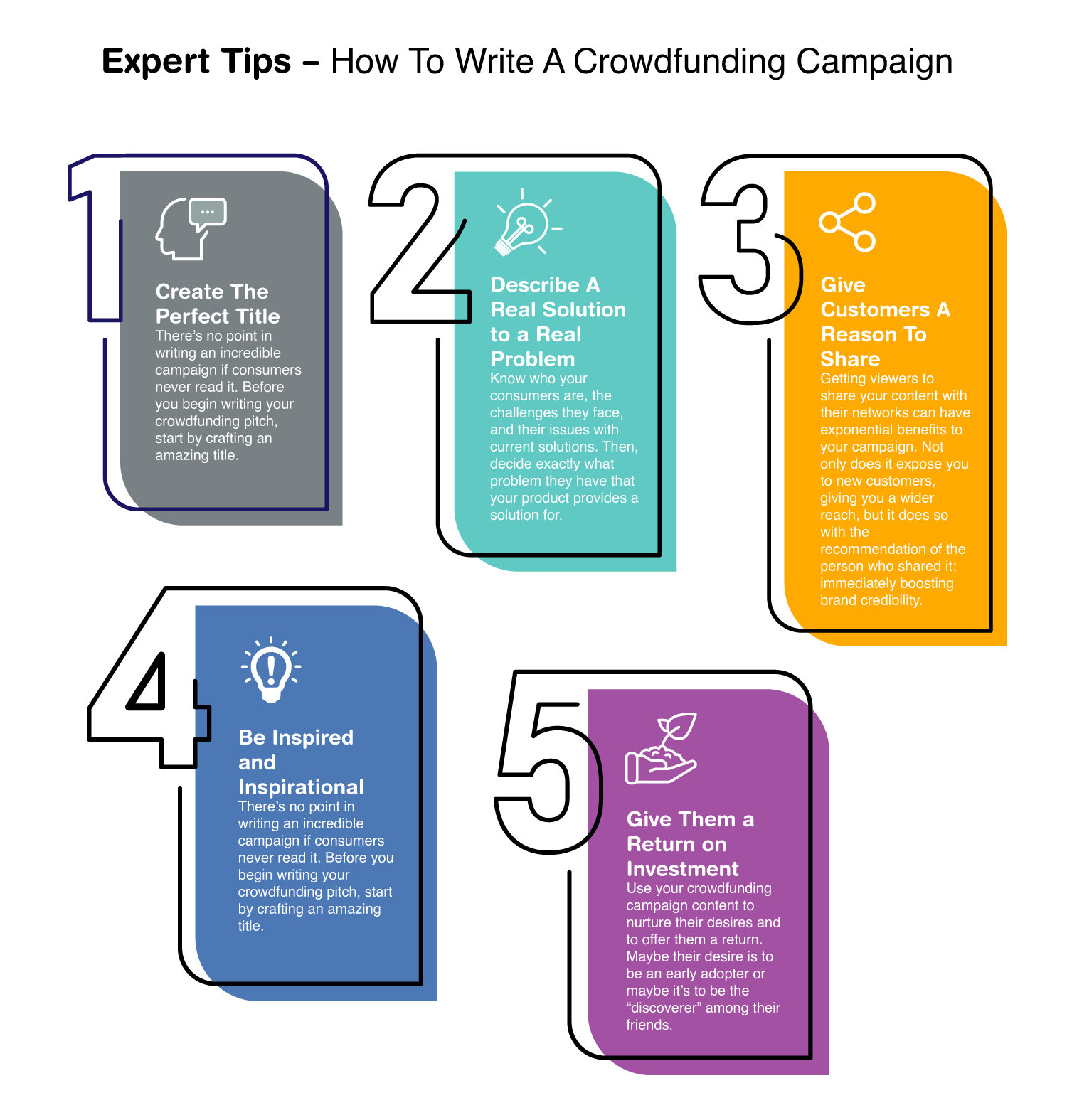Over the last few years, crowdfunding has risen to become an ideal avenue of raising capital for startups. During this time, thousands of businesses have raised billions of dollars to bring new innovations directly to consumers. Between 2014 and 2016, over $2.1 billion was raised through crowdfunding campaigns. By 2025, it is expected that total crowdfunding raised will reach over $300 billion. For those that know how to write a crowdfunding campaign, and can do so effectively, the potential is endless.
Crowdfunding is not easy, though. The average success rate of a crowdfunding campaign is 50%; so for every business that raises capital through this method, another business fails to meet its financial objective.
While there are many things that must be implemented to successfully meet your crowdfunding goal, it all starts with the pitch – or the crowdfunding campaign itself. If you’re looking for a template, you won’t find it here. Templates give you a “standard” way of doing something, but when it comes to effective crowdfunding, it’s the businesses that go outside the standard that succeed.
Whether you’re raising money on Kickstarter or one of the many Kickstarter alternatives, you’ll need a strong campaign to win. In this article, we’ll share several campaign tips and show you how to write a crowdfunding campaign to successfully raise funds for your startup.
Expert Tips – How To Write A Crowdfunding Campaign
1. Create The Perfect Campaign Name and Title
There’s no point in writing an incredible campaign if consumers never read it. Before you begin writing your crowdfunding pitch, start by crafting an amazing title.
The goal of a title is to persuade people to click through to the campaign. According to David Ogilvy, the Father of Advertising, “On average, five times as many people read the headline as read the body copy. When you have written your headline, you have spent eighty cents out of your dollar.” In other words, your title is probably just as, if not more, important than the actual body of your campaign.
Don’t name your campaign after your product, but use this real estate to woo consumers. Use it to capture people’s attention by being descriptive and detailing the benefits of the product. When someone reads your title, you want them to feel connected and driven to find out more. Let them know what your product is and give them a reason to want it – before they even get to your actual campaign! When thinking about your crowdfunding campaign title, consider these titles of campaigns that were successfully funded on Kickstarter:
- COOLEST COOLER’s: 21st Century Cooler that’s Actually Cooler
- Bring Reading Rainbow Back for Every Child, Everywhere!
- The Micro: The First Truly Consumer 3D Printer
2. Use Content to Describe A Real Solution to a Real Problem
People don’t buy stuff just because it’s cool… well, most people anyway. Consumers buy things that solve a real problem for them better than other solutions can. A new video game console may be entertaining, but people will only buy it if they perceive that it can entertain them better than their current gaming system. Consumers want products that allow them to solve their problems more easily, more accurately, or more efficiently.
Know who your consumers are, the challenges they face, and their issues with current solutions. Then, decide exactly what problem they have that your product provides a solution for. Here are a few crowdfunding examples of well-funded startups that used a problem/solution statement to stimulate consumers:
- G:Ro Carry-On Luggage’s Campaign – “We all know travel can be a hassle. The more you do it, the more tiring and frustrating it becomes. To get from here to there, too many of us depend on inferior bags, travel gear and accessories. So, we set out to design a bag that is better than anything else available.”
- eufyCam’s Crowdfunding Campaign: Wireless Security Camera – “Hate getting robbed? Love solving mysteries? Installing a security camera might seem like an obvious answer for surveillance, but it may surprise you that only 3 out of 10 homes have any sort of security device set up. And, as basic as a security camera system might seem, you’ll be surprised to know that other cameras on the market actually present more problems than solutions.”
- SuperBook Crowdfunding Example – “You already do a lot on your smartphone: it’s convenient, portable, and holds all of your apps, files, and contacts. In fact, you could accomplish a lot more with it, but are often held back by its small screen size and limited mobile interface. That’s why we created the Superbook – to remove those restrictions and give you the freedom of using just one computer.”
3. Write A Crowdfunding Campaign People Want to Share
Believe it or not, people don’t share online content because they “like” it. From a medical standpoint, sharing things with our network and receiving positive feedback (likes and comments) releases dopamine in our brains, giving us euphoria. To write a powerful campaign, you should know how to use your crowdfunding content to encourage specific user behaviors – like sharing. There are five main reasons why we share things on social media:
- To bring valuable and entertaining content to others.
- Define ourselves to others.
- To grow and nourish our relationships.
- Self-fulfillment.
- To get the word out about causes or brands.
Think about these factors as you develop the content for your campaign. Consider the second factor, for example – to define ourselves to others. This means, people may not share simply because they “agree” with your cause or brand, but because they want others to perceive them as someone who agrees with that product or brand.
In essence, the product you’re offering isn’t the only thing that must solve a problem for them – your content must do the same. While some consumers will just want to get the word out about your brand, remember that this is last on the list. Give them the dopamine release they are looking for with your content, and it will pay back in shares.
Getting viewers to share your content with their networks can have exponential benefits to your campaign. Not only does it expose you to new customers, giving you a wider reach, but it does so with the recommendation of the person who shared it; immediately boosting brand credibility.
4. Make Readers Feel Inspired With Your Campaign
Consumers who purchase from crowdfunding sites often don’t just want the product, but they find pleasure in being a part of the mission of the brand. They don’t just want to use a product, they want to be inspired by the brand’s existence and want to connect to the brand’s overall vision.
When writing a crowdfunding campaign, tell users about your story. Use your campaign to tell consumers why you exist, how you discovered the problem, and how your solution came about. Users connect to a brand story more emotionally than they do simply to brand claims. Of 1,000 consumers, 65% said they felt an emotional connection to a brand. From those individuals, 65% said they have an emotional connection to a brand because they make them feel, “like they care about people like me.”
If you want readers to connect to your brand, explain your mission in your campaign; displaying that you care about them and the challenges they face. Inspire consumers and give them a reason to connect with your brand. If successful, consumers will naturally turn into brand ambassadors; sharing the campaign and enticing their network to pre-purchase your product as well.
5. Sell Your Crowdfunding Campaign With Rewards
Just like when pitching investors, consumers also expect a return on their investment. Sure, they want to receive the incentive or reward that you’re offering in exchange for their money, but there are other reasons that they want to buy as well.
Use your crowdfunding campaign content to nurture their desires and to offer them a return. Maybe their desire is to be an early adopter or maybe it’s to be the “discoverer” among their friends. The better you understand your customer, the more effectively you can align your campaign to convince them to make a pre-purchase.
Putting Your Campaign Together
If your crowdfunding campaign achieves all the objectives stated, you’ve positioned yourself for crowdfunding success. These stats from a study of successful campaigns may provide you with some additional guidance when writing your campaign:
- The average number of words for a effective crowdfunding campaign is 609.
- The most popular campaign contribution reward level is between $10-25.
- The average number of rewards levels for a crowdfunding campaigns is 9.
Now that you know everything about writing a powerful campaign, all that’s left to do now is launch your campaign and promote it to everyone who will listen.
Need some help putting your campaign together? Contact ThinkLions today and speak with one of our startup funding experts! We’d love to help!










